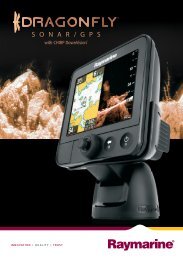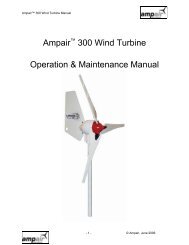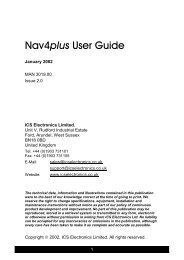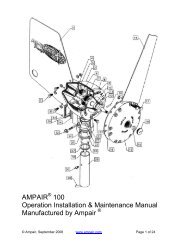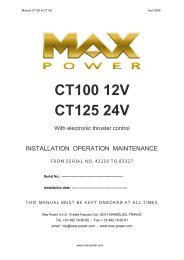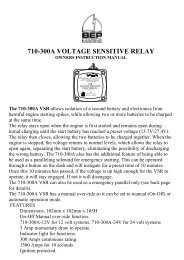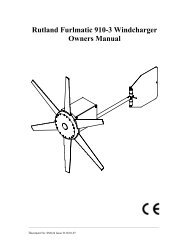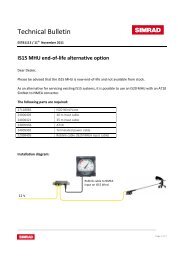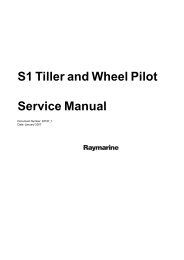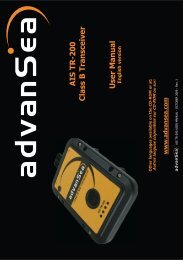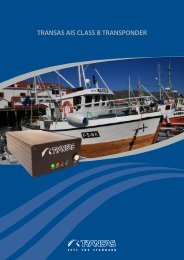Merlin VSR manual
Merlin VSR manual
Merlin VSR manual
Create successful ePaper yourself
Turn your PDF publications into a flip-book with our unique Google optimized e-Paper software.
SUMMARY:<br />
Thank you for purchasing a <strong>Merlin</strong> M-Power Voltage Sensitive Relay.<br />
Provided it is used and installed properly, it will provide years of dependable<br />
service. Please read this <strong>manual</strong> prior to installation, if in doubt contact<br />
<strong>Merlin</strong> Power Systems on 01202 697979.<br />
We draw your attention to CAUTION and WARNING statements throughout<br />
this <strong>manual</strong>. CAUTION statements relate to practices that could lead<br />
to damage of your electrical system. WARNING statements relate to<br />
practices that could lead to serious injury or death.<br />
CAUTION & WARNING! Read this <strong>manual</strong> before installation. We recommend<br />
that installation is completed by a qualified electrical engineer.<br />
USES:<br />
Your <strong>VSR</strong> can be used in a number of different configurations:<br />
1) As a split charger<br />
2) As a voltage sensitive switch<br />
1) As a Split Charger - The <strong>VSR</strong> is designed to sit between two<br />
batteries. When either is charged (above the Connect Voltage),<br />
the <strong>VSR</strong> will close and allow the other battery to charge. When<br />
charge is removed, voltage will drop to the Disconnect Voltage<br />
and the <strong>VSR</strong> will open. M-Power <strong>VSR</strong>’s are bi-directional - eg<br />
they will connect if either battery is being charged. Any number of<br />
<strong>VSR</strong>’s can be used to provide charging between any number of<br />
battery banks.<br />
2) The <strong>VSR</strong> can be used to switch on an appliance<br />
or load when, and only when the batteries<br />
are being charged. This is useful for items like<br />
onboard radio chargers that you would only<br />
want charged when the engine is running.<br />
LOCATION:<br />
<strong>VSR</strong>’s should be placed conveniently between<br />
battery banks. Keep battery cables as short as<br />
possible and ensure they are appropriately<br />
sized.<br />
<strong>Merlin</strong> Equipment recommends protecting all<br />
battery cables with fuses/circuit breakers.<br />
Your <strong>VSR</strong> can be installed under the hood/bonnet,<br />
engine compartment and on the inside of transoms for RIB’s and other<br />
craft. The <strong>VSR</strong> is designed to be water resistant but should not be fully<br />
or regularly immersed.<br />
BEFORE WORK:<br />
<strong>VSR</strong><br />
Battery<br />
To Load<br />
CAUTION & WARNING: Ensure you observe good electrical practices<br />
of workmanship. Ensure batteries are disconnected before starting work.<br />
Observe battery CAUTION & WARNING notices. Remove all jewellery<br />
and tie long hair back. Ensure that you wear appropriate clothing, personal<br />
safety equipment and use the correct tool for the job in hand.<br />
SIZING THE <strong>VSR</strong>:<br />
The <strong>VSR</strong> will handle a maximum current of 140A for approximately five<br />
minutes. Use the table below to ensure that the <strong>VSR</strong> is suitable for the<br />
installation.<br />
CAUTION: Do not overload the <strong>VSR</strong>.<br />
If you need a larger <strong>VSR</strong>, Speak to <strong>Merlin</strong> or your local dealer.<br />
Charging Source (Amps)<br />
20 50 80 100 120 150<br />
50Ah OK OK OK OK OK OK<br />
100Ah OK OK OK OK OK OK<br />
150Ah OK OK OK OK OK<br />
200Ah OK OK OK OK OK<br />
250Ah OK OK OK OK OK<br />
300Ah OK OK OK OK<br />
400Ah OK OK OK<br />
>500Ah OK OK OK<br />
Typical Installation: Single Engine<br />
1x alternator, 2x battery banks, 1x <strong>VSR</strong><br />
Typical Installation: Twin Engine<br />
2x alternator, 3x battery banks, 2x <strong>VSR</strong>s<br />
Typical Installation: Single Engine - Cascaded<br />
1x alternator, 3x battery banks, 2x <strong>VSR</strong><br />
Alternator<br />
Alternator<br />
Alternator<br />
Alternator<br />
Starter<br />
Motor<br />
M-Power<br />
<strong>VSR</strong><br />
Starter<br />
Motor<br />
M-Power<br />
<strong>VSR</strong><br />
M-Power<br />
<strong>VSR</strong><br />
Starter<br />
Motor<br />
Starter<br />
Motor<br />
M-Power<br />
<strong>VSR</strong><br />
M-Power<br />
<strong>VSR</strong><br />
Starter Battery<br />
Auxiliary Battery<br />
Starter Battery Auxiliary Battery Starter Battery<br />
Starter Battery Auxiliary Battery Winch Battery
<strong>VSR</strong> - REAR VIEW<br />
CAUTION: Connect battery connections first. Then connect ground to a<br />
common negative point or either battery negative.<br />
The left hand battery connection is for the battery that receives the Primary<br />
Charge (typically the engine battery). The right hand connection is<br />
for the auxiliary battery.<br />
DO NOT FORGET TO CONNECT THE BLACK GROUND WIRE!<br />
<strong>VSR</strong> - FIRST USE TESTS<br />
Ground Wire<br />
Battery<br />
Connections<br />
LH: Engine<br />
RH: Auxiliary<br />
1. Check the primary (engine) battery voltage using a multi meter.<br />
Note the voltage (typically 12.2-12.8V).<br />
2. Note the second (auxiliary) battery voltage using a multi meter.<br />
Note the voltage (typically 12.2-12.8V)<br />
3. Start the engine (or other charge source). Normally, the engine<br />
battery will replenish very quickly (sometimes in seconds). The<br />
Red “Connected” LED should illuminate on the <strong>VSR</strong>. If the engine<br />
battery is very low, it may take a while for the voltage to reach the<br />
<strong>VSR</strong>’s connect voltage point.<br />
4. Once the red LED is lit, use your multi Meter. Check the voltage<br />
on the second battery. It should be above that noted in Point 2<br />
above.<br />
5. If the <strong>VSR</strong> doesn't connect, check the voltage on the engine battery.<br />
It should be rising above the level you recorded in point 1<br />
above. If it isn't, there is a fault with the alternator/charge source.<br />
If it is above the Connect Voltage of the <strong>VSR</strong> (13.3V), ensure that<br />
the Negative Ground Wire is properly connected.<br />
FREQUENTLY ASKED QUESTIONS:<br />
Q: My <strong>VSR</strong> isn't connecting. What Shall I Check?<br />
A: Verify that the voltage of the charging system is actually rising beyond<br />
the <strong>VSR</strong>’s connect voltage (13.3V). If it is, check that the <strong>VSR</strong>’s<br />
ground cable is properly connected.<br />
Q: The Red Connected LED stays on / The <strong>VSR</strong> isn't disconnecting.<br />
Help!:<br />
A: The <strong>VSR</strong> will disconnect only when the system voltage (the mean<br />
voltage) between the engine and auxiliary battery reach 12.8V. Surface<br />
voltage (also known as phantom voltage) may mean that the voltage the<br />
<strong>VSR</strong> sees is around 13V for up to an hour after charging (prevalent on<br />
brand new and larger batteries). If you place a small load on the auxiliary<br />
battery, the <strong>VSR</strong> should disconnect shortly afterwards. Use a multi<br />
meter to check the voltage (of both batteries) if in doubt.<br />
Q: My <strong>VSR</strong> keeps “clicking”<br />
A: This is a normal function of a <strong>VSR</strong>. When the engine battery starts<br />
charging, voltage will rise. The <strong>VSR</strong> will cut in. If the auxiliary battery is<br />
very low, it will draw the overall system voltage down. The <strong>VSR</strong> will<br />
open again. The engine voltage starts to rise and the <strong>VSR</strong> reconnects<br />
(and continues to cycle on/off). It is quite normal for a few clicks over a 1<br />
-2 minute period (especially if the battery banks are low). If it continues<br />
for a lengthy period either a) the alternator (or other charge source) is<br />
significantly under powered for the battery bank size or b) the auxiliary<br />
battery bank is very large or c) the auxiliary battery is failing. If you are<br />
seeing continual <strong>VSR</strong> cycling (chatter), speak to a <strong>Merlin</strong> Engineer for<br />
help.<br />
Q: My <strong>VSR</strong> gets hot<br />
A: The <strong>VSR</strong> is designed to operate at an elevated temperature of ~50-<br />
60 degrees C. Ensure that the <strong>VSR</strong> has been sized properly according<br />
to the chart overleaf.<br />
For any other questions, please call us, check our website or speak to<br />
your local M-Power dealer.<br />
WARRANTY:<br />
Your <strong>VSR</strong> is warranted for two years from the date of purchase against<br />
defects in workmanship only. Either return your <strong>VSR</strong> to the point of purchase<br />
or log in directly to the <strong>Merlin</strong> Equipment warranty system at<br />
www.merlinequipment.com<br />
Please do not return any item to <strong>Merlin</strong> Equipment with obtaining an RMA<br />
number from our website. No responsibility or liability for goods will be<br />
accepted without an RMA number clearly attached to the returned product.<br />
MERLIN EQUIPMENT LIMITED<br />
UNIT 4, CABOT BUSINESS VILLAGE<br />
HOLYROOD CLOSE<br />
POOLE<br />
DORSET BH17 7BA<br />
T: +44 (0) 1202 697979<br />
F: +44 (0) 1202 691919<br />
www.merlinequipment.com




